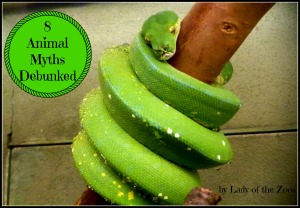 Down through the ages people have passed along their fears, phobias and misconceptions concerning animals. Most fears and phobias stem from a sense of the unknown; a fear of what you don’t know or understand. In turn, misconceptions are drawn. And so I’ve chosen from the plethora of animal myths that I’ve faced over the years and here are 8 Animal Myths Debunked.
Down through the ages people have passed along their fears, phobias and misconceptions concerning animals. Most fears and phobias stem from a sense of the unknown; a fear of what you don’t know or understand. In turn, misconceptions are drawn. And so I’ve chosen from the plethora of animal myths that I’ve faced over the years and here are 8 Animal Myths Debunked.
1. Probably the most widely thought is the myth that snakes are slimy. Over my years of working at the Zoo and with doing animal presentations this is the number one misconception I have heard from people. In actuality snakes as well as most reptiles are dry and smooth. The only time a snake is remotely slimy or wet is after it has soaked in water before it sheds its skin.
2. The second most popular myth is that porcupines shoot their quills. Porcupines utilize their quills as a defense mechanism. When threatened, the porcupine will turn its back, raise its quills and usually run backwards at its attacker. The quills do come out rather easily, so if another animal is stuck with them they will stay in their skin. They do not shoot out like rockets, but merely shaken are loosened and fall out.
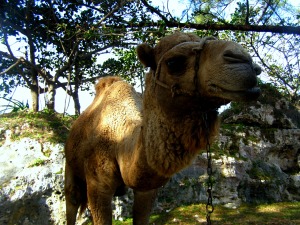 3. Another falsehood is that camels store water in their humps. The hump is actually a big mound of fat, useful because it provides the camel with the same amount of energy as three weeks worth of food. If there are any body parts that excel in retaining water it is the camel’s kidneys and intestines. These are so efficient that a camel’s urine comes out as thick as syrup and their feces is so dry it can be used to fuel fires. These remarkable creatures can survive seven days without water, but not because they are carrying large reserves inside their humps. They’re able to avoid dehydration due in large part to oval shaped red blood cells (versus the standard circular variety).
3. Another falsehood is that camels store water in their humps. The hump is actually a big mound of fat, useful because it provides the camel with the same amount of energy as three weeks worth of food. If there are any body parts that excel in retaining water it is the camel’s kidneys and intestines. These are so efficient that a camel’s urine comes out as thick as syrup and their feces is so dry it can be used to fuel fires. These remarkable creatures can survive seven days without water, but not because they are carrying large reserves inside their humps. They’re able to avoid dehydration due in large part to oval shaped red blood cells (versus the standard circular variety).
4. The fourth misconception is that rattlesnakes rattle their tail before they attack. In reality they only rattle when frightened, doing so to alert to their presence so as not to be tread on. They certainly don’t want to warn their prey before striking it.
5. One we heard a lot at the zoo while we were training a black jaguar cub for the animal presentations was that visitors thought it was a panther. Panthera is actually the taxonomy name for all the big cat species. Most people see a large black cat and think, mistakenly, it’s a panther, while it’s actually either a black jaguar (from Central/South America) or a black leopard (from Asia/Africa). The black seen is a melanistic skin colouring, instead of the tawny orange/yellow colour as is usual. Another interesting fact that many literally overlook is that the black cats still maintain their rosettes, the spot pattern on their coat. The rosettes are usually only clearly visible in sunlight.
6. Many frogs and toads have bumps on their skin that look like warts and whether it came from childhood fantasies or fairy tales many people believe that touching one of these little creatures will give you warts. Warts are actually caused by a human virus – NOT from frogs and toads. Some toads do have wart-like bumps behind the ear and can be dangerous. These parotid glands contain a nasty poison that irritates the mouths of predators and often the skin of humans.
7. ‘Blind as a bat’, we’ve all used this particular figure of speech at least once. But it’s another misnomer, bats aren’t blind at all. Along with using echolocation (sound bouncing off objects) bats see remarkably well. This, along with their great sense of smell certainly comes in handy when locating their young in a cave nest of thousands of bats.
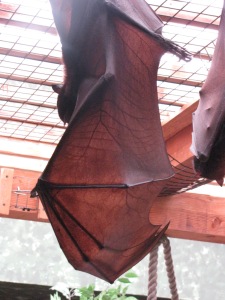 8. The last misconception can actually cause more harm than good. Many well-wishers believe that mother birds will reject their babies if they’ve been touched by humans. While learning to fly some hatchlings topple to the ground where some think it best to pick them up and place them back into the nest. It’s best to leave them alone, if needed the mother will return and aid it to freedom. Most birds have a poorly developed sense of smell and won’t even notice a human scent.
8. The last misconception can actually cause more harm than good. Many well-wishers believe that mother birds will reject their babies if they’ve been touched by humans. While learning to fly some hatchlings topple to the ground where some think it best to pick them up and place them back into the nest. It’s best to leave them alone, if needed the mother will return and aid it to freedom. Most birds have a poorly developed sense of smell and won’t even notice a human scent.
Like so many myths and misconceptions that flood the world of thought about many a topic, these eight animal myths are just a few of many. But when faced with new and or unknown circumstances or strange animal behaviour and appearance many people create fantasies or falsehoods out of ignorance. Just like people who all have a story to tell, animals do too, so remember to educate yourself, because the more you know and understand about a certain animal, the more likely you are to appreciate them and all they have to offer.
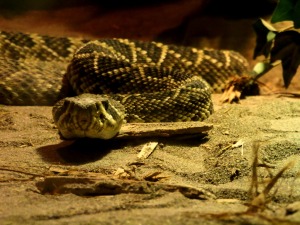
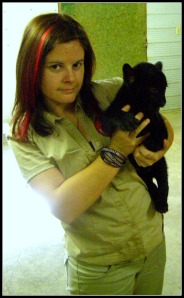



Interesting facts. I did think camels stored water in their humps…
Thanks! And don’t worry you aren’t the only one 🙂
hi there,
I really like your blog ! i feel i can learn a lot here : )
personally I am not a big fan of zoos, because I believe that animals should live in their suitable climate zone but of course zoos are highly educative to especially children.
Recently I read an article about future ideas to improve the image of zoo and the situation for animals: http://betterymagazine.com/stories/a-zoo-without-animals/
what do you think about these ideas ???
Thanks for your interest and support! The ideas in that article are interesting but people can’t get a true feeling or connection from an “unreal” animal. Seeing live animals at a great zoo can help create an understanding, appreciation and desire to save their wild counterparts and their habitats.
Great debunking; I probably thought a few of those on the list were true at one point. 🙂 Great article….love it!
Thanks so much!
Love this post! I’ve learnt so much from working with animals abroad and at London Zoo and some of the myths people believe about animals are hilarious! These are some classic ones though so good list 🙂
Thanks! It’s true, I don’t know how some got started but some of the things people think are true are hilarious!